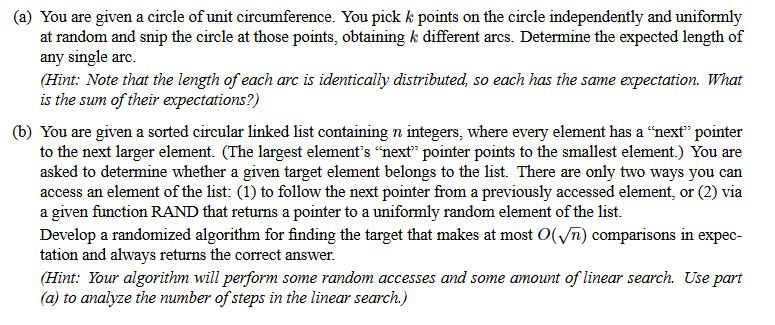
(a) You are given a circle of unit circumference. You pick k points on the circle independently and uniformly at random and snip the circle at those points, obtaining k different arcs. Determine the expected length of any single arc Hint: Note that the length of each arc is identically distributed, so each has the same expectation. What is the sum of their expectations?) (b) You are given a sorted circular linked list containing n integers, where every element has a "next pointer to the next larger element. (The largest element's "next" pointer points to the smallest element.) You are asked to determine whether a given target element belongs to the list. There are only two ways you can access an element of the list: (1) to follow the next pointer from a previously accessed element, or (2) via a given function RAND that returns a pointer to a uniformly random element of the list. Develop a randomized algorithm for finding the target that makes at most O(Vn) comparisons in expec- tation and always returns the correct answer. (a) to analyze the number of steps in the linear search.) (a) You are given a circle of unit circumference. You pick k points on the circle independently and uniformly at random and snip the circle at those points, obtaining k different arcs. Determine the expected length of any single arc Hint: Note that the length of each arc is identically distributed, so each has the same expectation. What is the sum of their expectations?) (b) You are given a sorted circular linked list containing n integers, where every element has a "next pointer to the next larger element. (The largest element's "next" pointer points to the smallest element.) You are asked to determine whether a given target element belongs to the list. There are only two ways you can access an element of the list: (1) to follow the next pointer from a previously accessed element, or (2) via a given function RAND that returns a pointer to a uniformly random element of the list. Develop a randomized algorithm for finding the target that makes at most O(Vn) comparisons in expec- tation and always returns the correct answer. (a) to analyze the number of steps in the linear search.)







